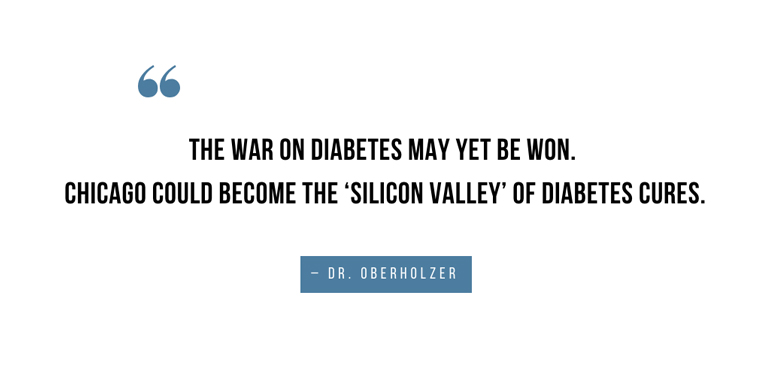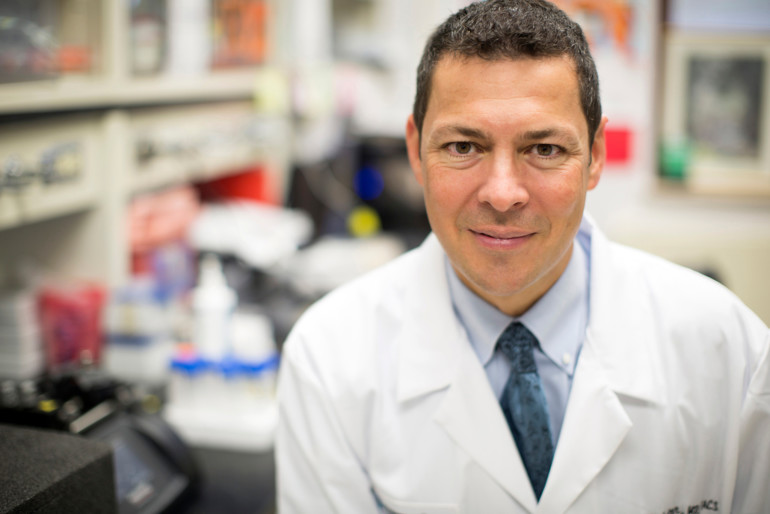If you or a loved one lives with type 1 diabetes (T1D), the constant battle with fluctuating blood sugar levels is far too familiar. Daily life is suddenly brought to a screeching halt when the body demands insulin.
Chicago Diabetes Project (CDP) is teaming up with an elite group of scientists, researchers, physicians, and surgeons to pioneer a functional cure for diabetes.

Through an islet cell transplant, CDP aims to significantly reduce the need for medication, reduce medical costs and unpredictable and life-threatening drops in blood sugar levels, increase patient independence, and create a life free of insulin injections.
Led by CDP founder and director José Oberholzer, MD, MHCM, FACS, the team has performed over 600 human islet isolations; both transplantation and research. According to the Clinical Islet Transplant Consortium (CIT), over 1,000 patients have received an islet cell transplant to date.
Dr. Oberholzer is a researcher, surgeon, and professor of surgery, biomedical engineering, and experimental pathology. Oberholzer also serves as chief of transplant surgery and director of Charles O. Strickler Transplant Center at the University of Virginia.
We have the inside scoop from CDP and Dr. Oberholzer on the latest research and developments in the team’s critical work to cure diabetes.
Better: What is the mission of Chicago Diabetes Project?
Dr. Oberholzer: The Chicago Diabetes Project provides funding to a global collaboration of scientists, researchers, physicians, and surgeons with one mission: to functionally cure diabetes. The CDP is working to functionally cure diabetes by transplanting insulin-producing islet cells into diabetic patients, which would reduce or eliminate the need for multiple exogenous insulin injections daily and provide better control of blood glucose levels. Our mission is to develop and perfect this procedure in the shortest time possible, without the need for immunosuppressive drugs. Eliminating the use of immunosuppressive drugs will make the procedure more affordable, reduce side effects, and allow the procedure to serve a broader patient population.
Why is the current standard of care (exogenous insulin, pumps, glucose sensors, etc.) insufficient for patients with T1D?
There have been great technological advances in the last several years that help many diabetics improve glycemic control. However, there is a subset of patients diagnosed with brittle T1D. These worst case T1D patients no longer feel when their blood sugars drop to life threatening low levels (hypoglycemic unawareness). An islet cell transplant can not only prevent patients with brittle T1D from going dangerously low, but in most cases will also allow them to live a life without insulin injections. Furthermore, many “standard of care” technologies rely on patient compliance and can be a financial burden for the patients or caregivers. An islet transplant will provide the patient with more autonomy and reduce medical costs over their lifetime.
What is allogeneic islet transplantation and why is it a better alternative than the standard of care?
In an allogeneic islet transplant, islets are taken from the pancreas of a deceased organ donor. The islets are purified, processed, and transplanted to a patient with brittle T1D. Once transplanted, the beta cells in the islets begin to make and release insulin. For most patients, islet transplantation eliminates hypoglycemic unawareness and provide a “functional cure” so that they no longer require daily injections of insulin. Furthermore, improved glycemic control achieved after an islet transplant prevents secondary complications associated with the microvasculature, which include cardiovascular disease, neuropathy, nephropathy, and retinopathy.
What can be done to expand access to allogeneic islet transplantation — an experimental procedure that can serve as a sustainable cure for T1D? What barriers need to be addressed?
The Food and Drug Administration (FDA) has determined that the islet purification process is beyond the criteria in the code of federal regulations regarding minimal manipulation. Because of this, islets are regulated as a biologic drug. For an islet cell transplant to be considered a standard care option, it is necessary to receive FDA approval of the biologic drug “islet cells.” A biologic license application (BLA) is an enormous task with a high level of scrutiny. Once a BLA for islet cells is approved, insurance coverage, medical procedural and billing codes are also necessary to remove barriers to access which will make the procedure more affordable for diabetic patients. These steps are costly. In the meantime, the CDP supports patients who need an islet cell transplant through restricted grants to medical centers that are approved by the FDA to perform the procedure.
Aside from islet transplantation, what existing and/or emerging research or technologies are most promising to serve as an artificial pancreas?
The CDP supports important research investigations to improve upon allogeneic islet transplantation. As with any transplant, anti-rejection (immunosuppressive) drugs must be taken, which can have a range of adverse side effects. To eliminate the need for these medications, the CDP supports work to encapsulate islets to protect them from the host’s immune system. The CDP also supports work which utilizes the blood of T1D patients to learn new information about the innate and fibrotic responses to biomaterials in order to establish draft protocols for clinical trials/biocompatibility testing and implantation of capsules in patients with T1D.
A limitation that CDP investigators are addressing is that of cell source. Islet cells from deceased donors (i.e. cadaveric islets) are limited and cannot always be utilized due to the quality of the pancreas and time for acquisition post-mortem. Our collaborators are working to induce growth of human donor islets in vitro. They aim to deliver well-defined growth promoting factors to stimulate the growth of human insulin-producing beta cells in a clinically applicable manner. Other collaborators are working on creating new islet cells starting from stem cells. Others are still developing porcine islets as unlimited cell source.
Another approach the CDP supports applies a novel platform that uses robotic technology and mathematically determined experimental designs for the extraction of industrial grade parameters for the manufacture of human pancreatic cells.
What are the major barriers to advancing these technologies from the research bench to the clinic?
Funding is a major barrier to support the costly and complex research. These experiments are expensive. Grant funding is often slow and delayed. The CDP can provide timely seed grants to our investigators that can help bridge delays from larger funding agencies.
How does CDP help advance ongoing diabetes research, including international collaborations, grants, etc.?
The CDP advances ongoing diabetes research through collaborations and grant funding. We facilitate communication and sharing of experimental results among collaborating teams. We also add nimbleness to the research by providing funding for critical experiments that may not be covered by other grants.
What type of work has been funded by the CDP to date and what is the current status?
The CDP supports islet cell transplant clinical trials, encapsulation technologies and research to solve the problem of an unlimited insulin producing cell source.
Does CDP offer resources to patients and families impacted by T1D?
Yes, the CDP supports the follow-up care of patients who have received an islet cell transplant. Since the procedure is considered experimental, medical costs are often not covered by insurance companies. The CDP provides scientific updates to educate patients and families regarding the research and work towards a functional cure. The CDP holds video conferences, yearly events and lab tours with our scientists and researchers for anyone who would like to learn more.
How can individuals help with CDP’s mission?
The CDP welcomes volunteers for our events. We have an annual poker & casino night, charity running teams, baseball tournament and new events every year. Reach out to us on our website or on Facebook. And of course, we need funding. Every dollar counts.
To learn more, please contact Jill Dine (Jill@chicagodiabetesproject.org) or Patsy Carrane (Patsy@chicagodiabetesproject.org).

